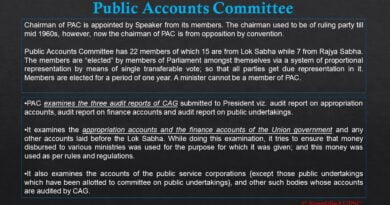Parvatmala Scheme
Ministry of Road Transport and Highways (MORTH)
Context:
Recently, the Union Finance Minister in the Union Budget for 2022-23 announced National Ropeways Development Programme – “Parvatmala” to improve connectivity in hilly areas.
Contents
About Parvatmala Scheme
- Parvatmala Scheme is an ecologically sustainable alternative in place of conventional roads in difficult hilly areas.
- The scheme will be taken up on PPP (Public Private Partnership) mode,
- Besides promoting tourism, the objective is to improve connectivity and convenience for commuters.
- This scheme is also suitable for the implementation in congested urban areas where a traditional mass transit system would be impractical.
- According to the Finance Minister, contracts for eight 60-kilometre ropeway projects will be given in 2022-23.
- Currently, the scheme is being implemented in Uttarakhand, Himachal Pradesh, Manipur, Jammu and Kashmir, and other North-Eastern states.
MoU with Uttrakhand
- MORTH initiated a study carried out by M/s Mckinsey & Co. for Ropeway development in the country. The study suggested that MORTH may take National Ropeway Development Programme named “Parvatmala”, similar to the “Bharatmala” programme.
- An MoU has been signed with Uttarakhand Tourism Development Board (UTDB), for the development of Ropeways in the State. Initially, seven projects have been identified in Uttarakhand.
- Currently, DPR for Kedarnath and Hemkund Sahib Ropeway is in progress, for which NIT has been invited. The Ministry has received proposals from Governments of Himachal Pradesh, Manipur, Arunachal Pradesh, Sikkim, Maharashtra, Jammu and Kashmir for the development of Ropeways.
Who is the Nodal Ministry?
- The Ministry of Road Transport and Highways (MORTH) will have responsibility for development of ropeway and alternative mobility solutions technology, as well as construction, research, and policy in this area.
- In February 2021, the Government of India (Allocation of Business) Rules 1961 was amended, which enabled the MORTH to also look after the development of Ropeways and Alternate Mobility Solutions.
- The move will give a boost to the sector by setting up a regulatory regime.
- The MORTH has so far been responsible for development of Highways and regulating the road transport sector across the country.
Idea behind Ropeways Infrastructure
- Cost-Effective Alternative: Ropeways are an economical means of transportation since they are built in a straight route over mountainous terrain, resulting in lower land acquisition expenses. As a result, while having a greater construction cost per kilometre than motorways, ropeway projects may be more cost-effective than roadways.
- Faster & Better: Ropeways offer an advantage over roadway projects since they can be erected in a straight line, even over mountainous terrain, because they are an aerial means of transportation.
- Sustainable Alternative: Ropeways can pave the way towards low dust emissions which is good for the environment. Material containers can be built to prevent environmental contamination.
- Last mile connectivity: Ropeways are preferably better for last-mile connectivity ease. The projects using 3S (a type of cable car system) or related technologies can transport 6000-8000 passengers in the last mile
Benefits of Ropeways
Economical mode of transportation: Given that ropeway projects are built in a straight line over hilly terrain, it results in lower land acquisition costs. Hence, despite having a higher cost of construction per km than roadways, ropeway projects construction cost may happen to be more economical than roadways.
Faster mode of transportation: Owing to the aerial mode of transportation, ropeways have an advantage over roadway projects where ropeways can be built in a straight line, over a hilly terrain.
Environmentally friendly: Low dust emissions. Material containers can be designed to rule out any soiling of the environment.
Last-mile connectivity: Ropeway projects adopting 3S (a kind of cable car system) or equivalent technologies can transport 6000-8000 passengers per hour.
Ideal for difficult/challenging/sensitive terrain: This mode of transportation will enable mobility to people living in difficult areas and help them become part of the mainstream.
Flexible: Transport of different materials – A ropeway allows for the simultaneous transport of different types of material.
Ability to handle large slopes: Ropeways and cableways (cable cranes) can handle large slopes and large differences in elevation. Where a road or railroad needs switchbacks or tunnels, a ropeway travels straight up and down the fall line.
What is the National Ropeways Development Programme?
Nodal Ministry: Ministry of Road Transport and Highways (MORTH)
Aim: To develop Ropeways in hilly areas of the country in a Public-Private Partnership (PPP) mode.
Around 8 ropeway projects for a length of 60 km would be awarded in 2022-23.
The programme will also cover congested urban areas, where conventional mass transit systems are not feasible.
The programme is being presently started in regions like Uttarakhand, Himachal Pradesh, Manipur, Jammu & Kashmir and the other North-Eastern states.
Source: PIB
You can find many articles on SCHEMES (part of GS II) in our website. Go through these articles share with your friends and post your views in comment section.
Discover more from Simplified UPSC
Subscribe to get the latest posts sent to your email.



